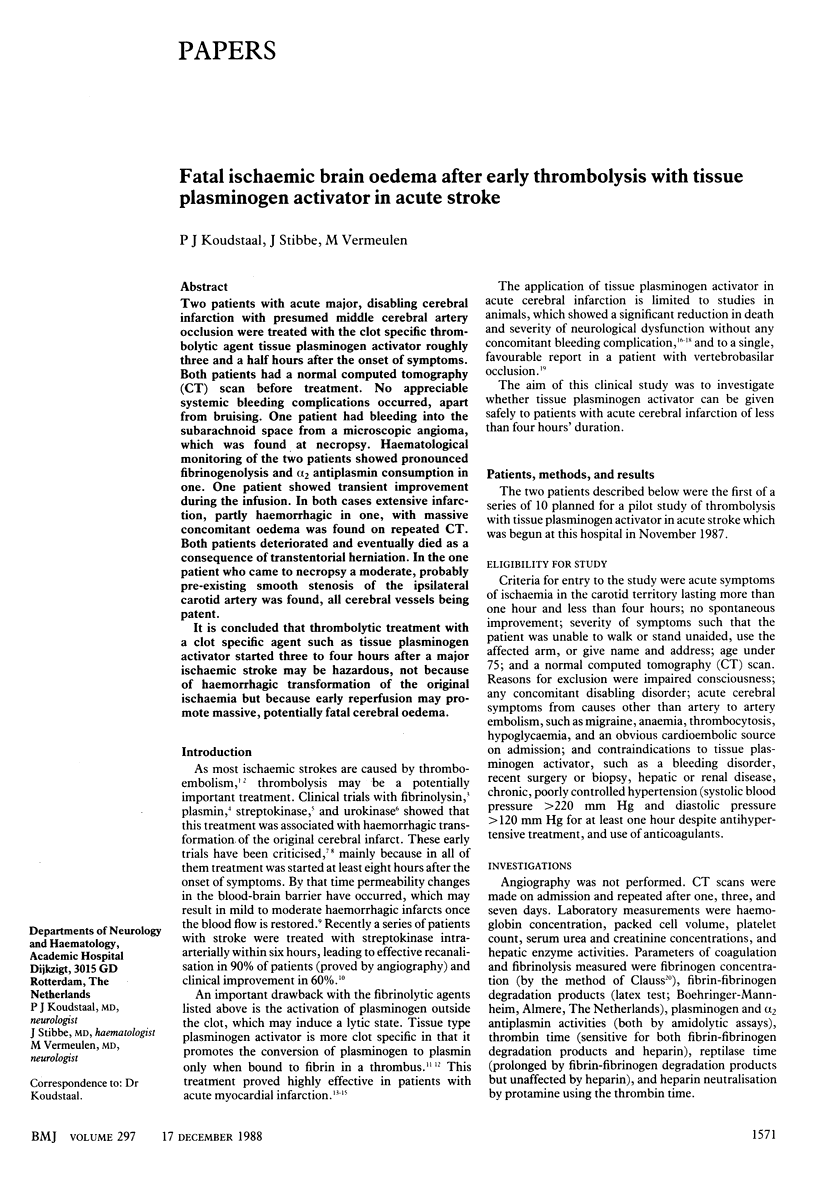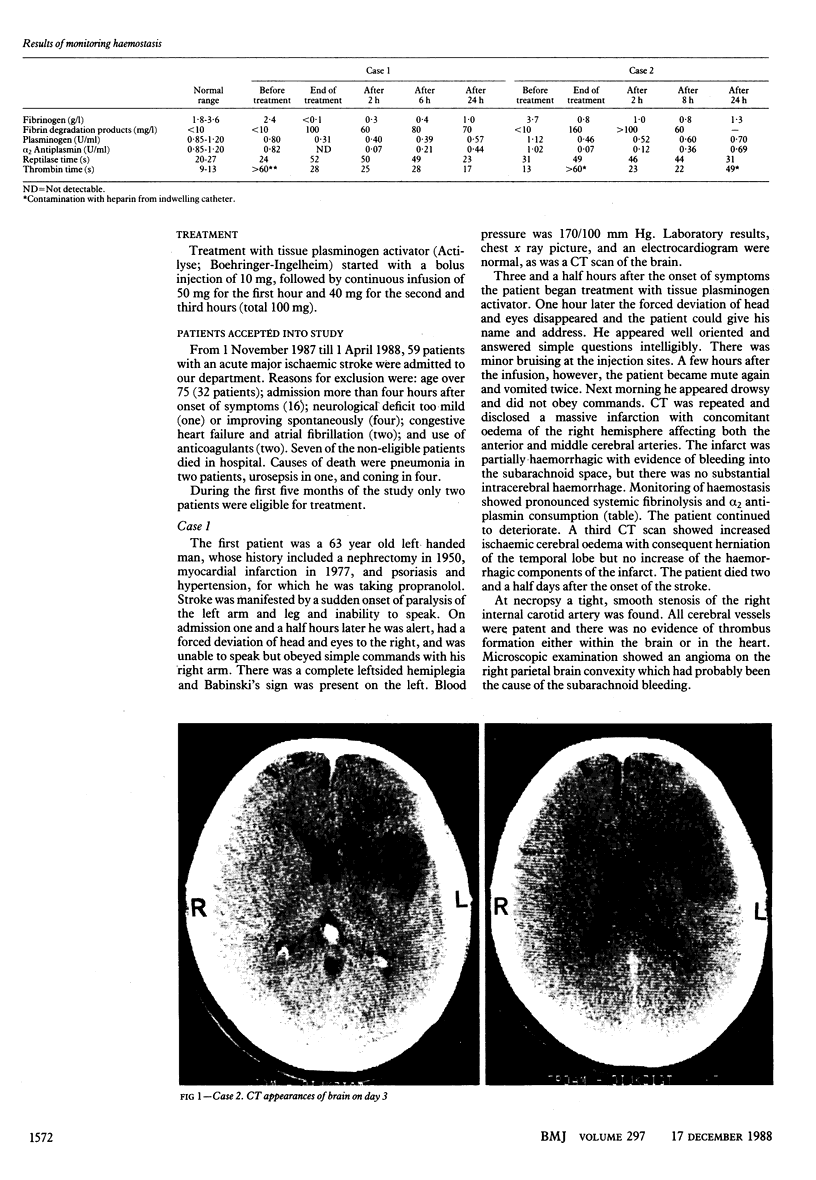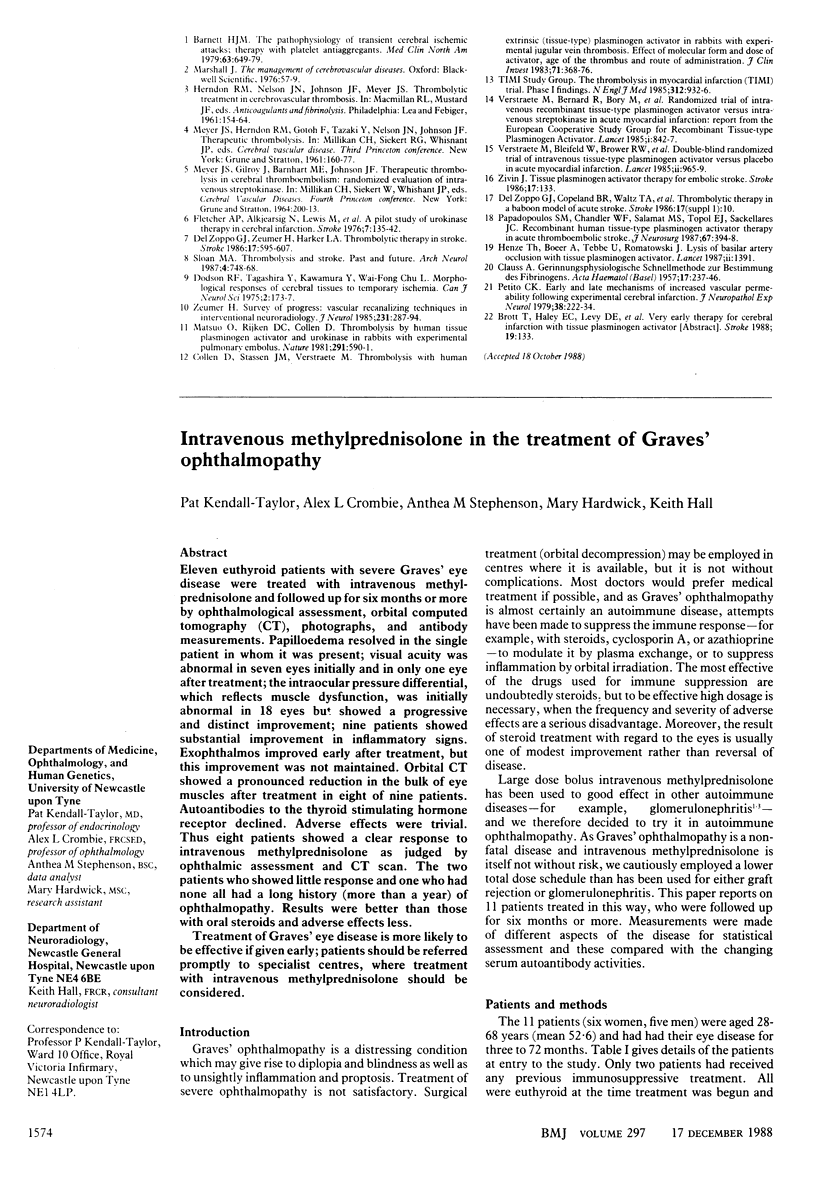Abstract
Two patients with acute major, disabling cerebral infarction with presumed middle cerebral artery occlusion were treated with the clot specific thrombolytic agent tissue plasminogen activator roughly three and a half hours after the onset of symptoms. Both patients had a normal computed tomography (CT) scan before treatment. No appreciable systemic bleeding complications occurred, apart from bruising. One patient had bleeding into the subarachnoid space from a microscopic angioma, which was found at necropsy. Haematological monitoring of the two patients showed pronounced fibrinogenolysis and alpha 2 antiplasmin consumption in one. One patient showed transient improvement during the infusion. In both cases extensive infarction, partly haemorrhagic in one, with massive concomitant oedema was found on repeated CT. Both patients deteriorated and eventually died as a consequence of transtentorial herniation. In the one patient who came to necropsy a moderate, probably pre-existing smooth stenosis of the ipsilateral carotid artery was found, all cerebral vessels being patent. It is concluded that thrombolytic treatment with a clot specific agent such as tissue plasminogen activator started three to four hours after a major ischaemic stroke may be hazardous, not because of haemorrhagic transformation of the original ischaemia but because early reperfusion may promote massive, potentially fatal cerebral oedema.
Full text
PDF



Images in this article
Selected References
These references are in PubMed. This may not be the complete list of references from this article.
- Barnett H. J. The pathophysiology of transient cerebral ischemic attacks. Med Clin North Am. 1979 Jul;63(4):649–679. doi: 10.1016/s0025-7125(16)31667-4. [DOI] [PubMed] [Google Scholar]
- CLAUSS A. Gerinnungsphysiologische Schnellmethode zur Bestimmung des Fibrinogens. Acta Haematol. 1957 Apr;17(4):237–246. doi: 10.1159/000205234. [DOI] [PubMed] [Google Scholar]
- Collen D., Stassen J. M., Verstraete M. Thrombolysis with human extrinsic (tissue-type) plasminogen activator in rabbits with experimental jugular vein thrombosis. Effect of molecular form and dose of activator, age of the thrombus, and route of administration. J Clin Invest. 1983 Feb;71(2):368–376. doi: 10.1172/JCI110778. [DOI] [PMC free article] [PubMed] [Google Scholar]
- Del Zoppo G. J., Zeumer H., Harker L. A. Thrombolytic therapy in stroke: possibilities and hazards. Stroke. 1986 Jul-Aug;17(4):595–607. doi: 10.1161/01.str.17.4.595. [DOI] [PubMed] [Google Scholar]
- Dodson R. F., Tagashira Y., Kawamura Y., Chu L. W. Morphological responses of cerebral tissues to temporary ischemia. Can J Neurol Sci. 1975 Aug;2(3):173–177. doi: 10.1017/s0317167100020217. [DOI] [PubMed] [Google Scholar]
- Fletcher A. P., Alkjaersig N., Lewis M., Tulevski V., Davies A., Brooks J. E., Hardin W. B., Landau W. M., Raichle M. E. A pilot study of urokinase therapy in cerebral infarction. Stroke. 1976 Mar-Apr;7(2):135–142. doi: 10.1161/01.str.7.2.135. [DOI] [PubMed] [Google Scholar]
- Henze T., Boeer A., Tebbe U., Romatowski J. Lysis of basilar artery occlusion with tissue plasminogen activator. Lancet. 1987 Dec 12;2(8572):1391–1391. doi: 10.1016/s0140-6736(87)91275-x. [DOI] [PubMed] [Google Scholar]
- Matsuo O., Rijken D. C., Collen D. Thrombolysis by human tissue plasminogen activator and urokinase in rabbits with experimental pulmonary embolus. Nature. 1981 Jun 18;291(5816):590–591. doi: 10.1038/291590a0. [DOI] [PubMed] [Google Scholar]
- Papadopoulos S. M., Chandler W. F., Salamat M. S., Topol E. J., Sackellares J. C. Recombinant human tissue-type plasminogen activator therapy in acute thromboembolic stroke. J Neurosurg. 1987 Sep;67(3):394–398. doi: 10.3171/jns.1987.67.3.0394. [DOI] [PubMed] [Google Scholar]
- Petito C. K. Early and late mechanisms of increased vascular permeability following experimental cerebral infarction. J Neuropathol Exp Neurol. 1979 May;38(3):222–234. doi: 10.1097/00005072-197905000-00003. [DOI] [PubMed] [Google Scholar]
- Sloan M. A. Thrombolysis and stroke. Past and future. Arch Neurol. 1987 Jul;44(7):748–768. doi: 10.1001/archneur.1987.00520190052017. [DOI] [PubMed] [Google Scholar]
- Verstraete M., Bernard R., Bory M., Brower R. W., Collen D., de Bono D. P., Erbel R., Huhmann W., Lennane R. J., Lubsen J. Randomised trial of intravenous recombinant tissue-type plasminogen activator versus intravenous streptokinase in acute myocardial infarction. Report from the European Cooperative Study Group for Recombinant Tissue-type Plasminogen Activator. Lancet. 1985 Apr 13;1(8433):842–847. doi: 10.1016/s0140-6736(85)92208-1. [DOI] [PubMed] [Google Scholar]
- Verstraete M., Bleifeld W., Brower R. W., Charbonnier B., Collen D., de Bono D. P., Dunning A. J., Lennane R. J., Lubsen J., Mathey D. G. Double-blind randomised trial of intravenous tissue-type plasminogen activator versus placebo in acute myocardial infarction. Lancet. 1985 Nov 2;2(8462):965–969. doi: 10.1016/s0140-6736(85)90523-9. [DOI] [PubMed] [Google Scholar]
- Zeumer H. Vascular recanalizing techniques in interventional neuroradiology. J Neurol. 1985;231(6):287–294. doi: 10.1007/BF00313704. [DOI] [PubMed] [Google Scholar]




